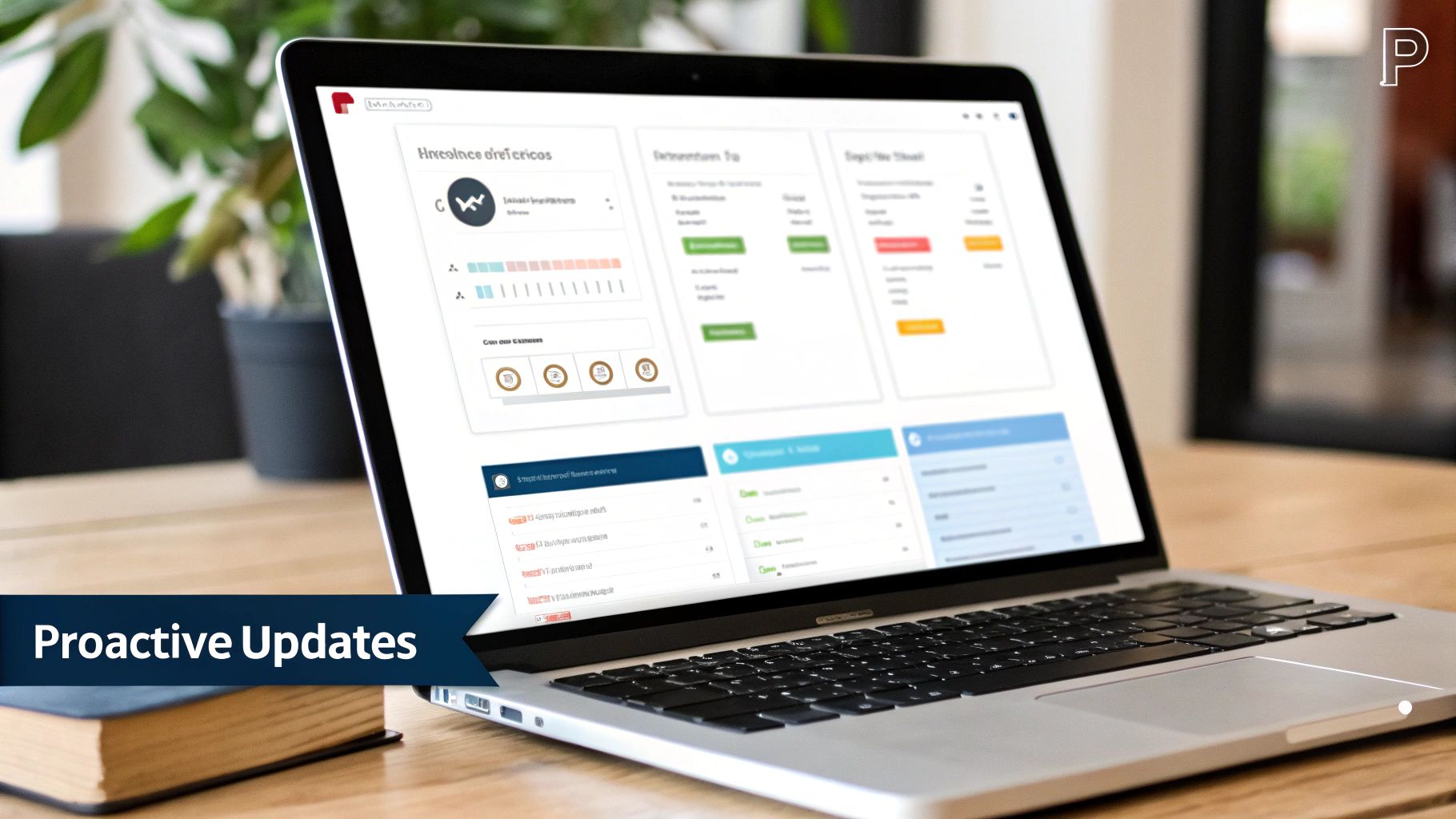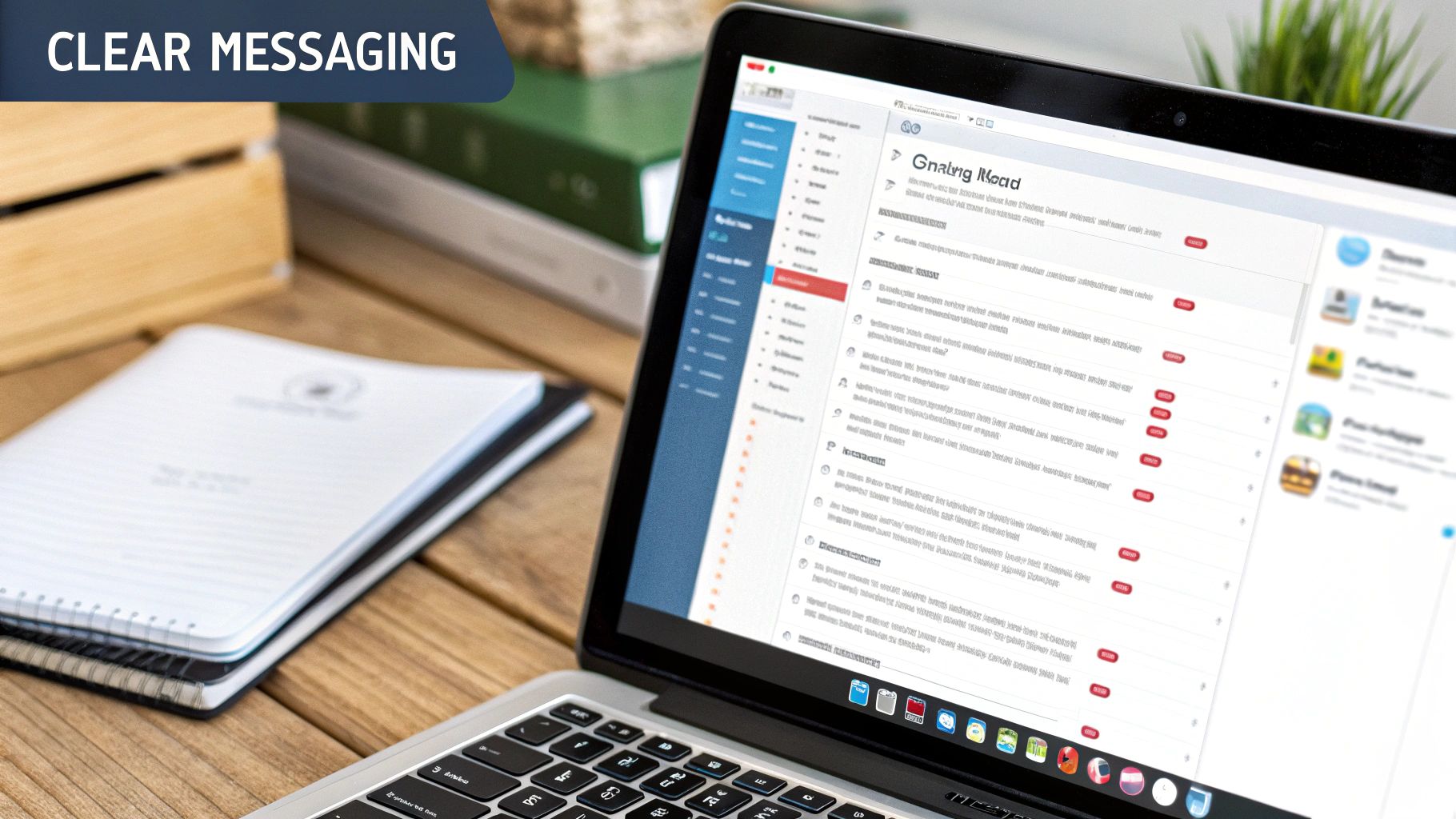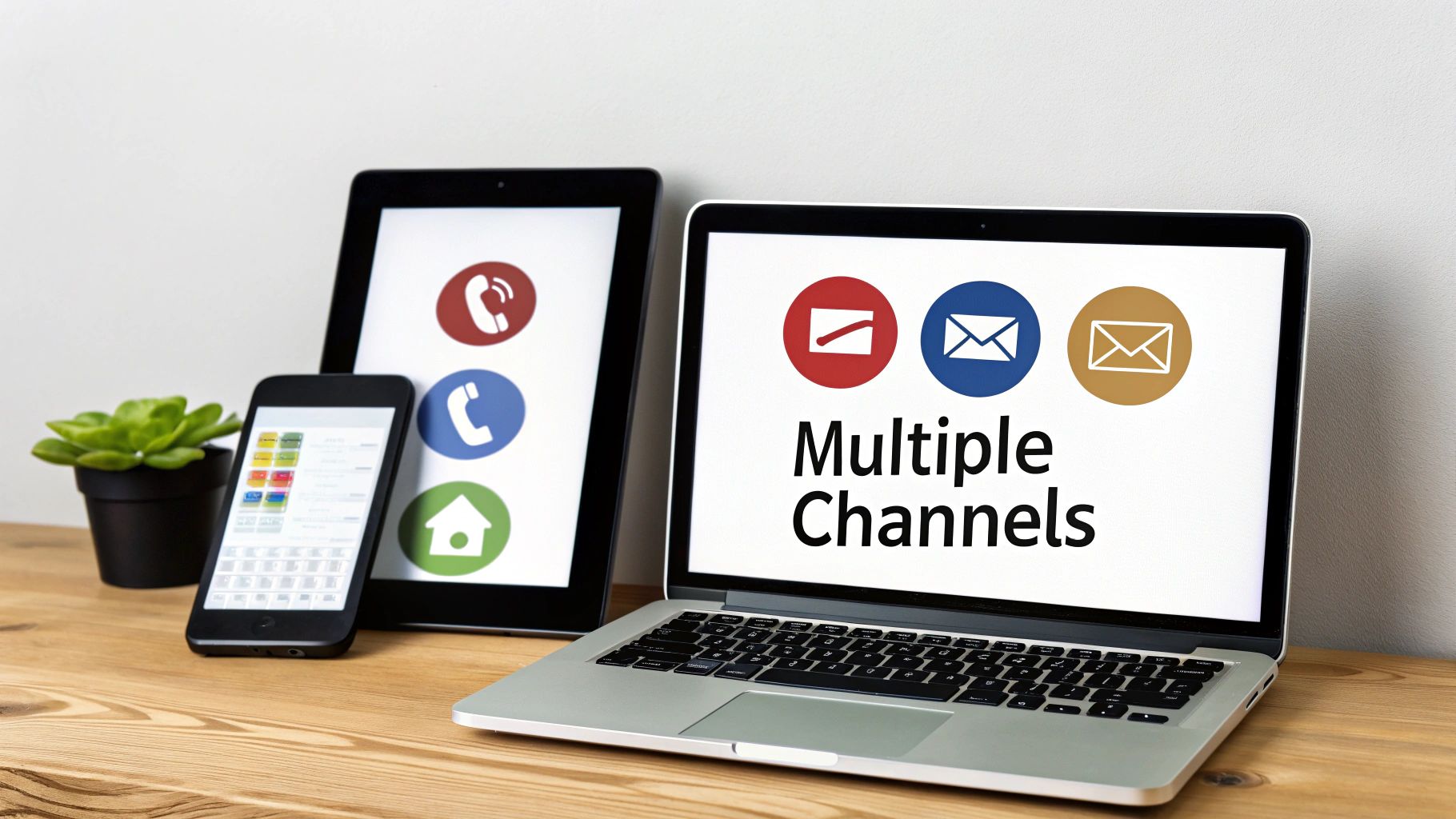Ever sent a crucial project update into the black hole of a client's inbox, only to be met with silence and mounting anxiety? Or worse, you thought you were perfectly aligned, but a "quick question" from the client reveals a massive misunderstanding that threatens to derail the entire project. This communication gap is a draining, all-too-common pain point that turns promising partnerships into stressful, reactive firefighting.
Quick Win: For your very next client email, add a single sentence at the end: "Does this plan align with your expectations, and are there any immediate roadblocks you foresee?" This simple question shifts the dynamic from a one-way announcement to a two-way confirmation, preventing misunderstandings before they start.
This article moves beyond generic advice. We'll break down seven actionable client communication best practices with step-by-step guidance you can implement today. Forget fluff—these are the frameworks and tactics that build unbreakable client relationships and turn communication from a liability into your greatest asset.
1. Master Active Listening and Acknowledgment
True communication isn't about what you say; it's about what the client feels you've heard. When clients don't feel understood, small misalignments quickly become major project crises. Active listening isn't just waiting for your turn to talk—it's a focused effort to understand the core message, intent, and emotion behind your client's words. This foundational practice is one of the most powerful client communication best practices for building a bedrock of trust.

Real-World Use Case: The Zappos Method
Legendary online shoe retailer Zappos built its brand on exceptional customer service, rooted in active listening. Their representatives are trained not to rush to a solution but to listen to the customer's entire story, acknowledge their frustration, and then paraphrase the issue back to confirm understanding ("So, what I'm hearing is the shoes arrived a day late, which caused you to miss wearing them for a special event. That must have been incredibly frustrating."). This doesn't just solve the problem; it creates an emotional connection and builds fierce loyalty, turning a one-time buyer into a lifelong advocate.
How to Implement Active Listening: Step-by-Step
Focus Intensely: On your next call, close all other tabs. Silence your phone. Give the client your undivided attention.
Paraphrase to Confirm: After the client shares a key point, repeat it back in your own words. Use phrases like, "So, if I'm understanding correctly, the main priority is X, not Y. Is that right?"
Ask Clarifying "What" and "How" Questions: If a client says a design feels "off," don't guess what they mean. Ask, "What specific element is drawing your attention?" or "How would you describe the feeling you're hoping to achieve?"
Acknowledge and Validate: Use simple, empathetic phrases like, "I can see why that's a concern," or "That's a valid point." This shows you respect their perspective, even if you don't agree.
Pro Tip: In your next client meeting, use a "notes and summary" technique. In your project tool or a shared document, create two columns: one for raw notes during the conversation, and another for a "Key Takeaways & Action Items" summary. Share this summary with the client within an hour of the call. This not only confirms alignment but also creates a tangible record of the conversation.
2. Be Proactive, Not Reactive, with Updates
That sinking feeling when a client emails with "Just checking in..." is a sign of reactive communication. It means they're feeling anxious because they don't know what's going on. The antidote is proactive communication: providing information before they even think to ask. This shift is a cornerstone of effective client communication best practices, turning client anxiety into confidence.

Real-World Use Case: Basecamp's "Calm Company" Ethos
Software company Basecamp built its entire platform and company culture around proactive, transparent communication. Their system is designed for teams to post progress updates, share files, and discuss issues in a central, client-accessible space. This eliminates the need for constant status meetings and "checking in" emails. By making communication visible by default, Basecamp empowers clients to see progress in real-time, which reduces anxiety and frees up their team to focus on the actual work.
How to Implement Proactive Communication: Step-by-Step
Set a Communication Cadence: During onboarding, define a clear schedule for updates. For example: "You'll receive a Weekly Progress Summary in your growlio client portal every Friday at 4 PM." This is a key part of strong client onboarding best practices on growlio.io.
Use Update Templates: Create simple, reusable templates for weekly updates, milestone completions, or issue alerts. This ensures consistency and professionalism.
Share Bad News Early: If you foresee a delay or issue, communicate it immediately. Always present the problem along with a proposed solution or a clear plan to find one. This builds immense trust.
Pro Tip: Create a “Client Dashboard” in your project management tool (like growlio). This dashboard should be the single source of truth, featuring:
Key project milestones with status (e.g., Not Started, In Progress, Complete).
A running log of all communications and decisions.
Direct links to important files or deliverables. Share this with your client and direct them to it whenever they have a question about project status.
3. Establish Clear and Consistent Messaging
Does your client seem confused by conflicting information from different team members? When a project manager promises one timeline while a developer hints at another, it creates uncertainty and erodes trust. One of the most vital client communication best practices is to establish a single source of truth and a unified voice.

How to Implement Consistent Messaging: Step-by-Step
Designate a Single Point of Contact (SPOC): For each project, assign one person as the primary liaison for the client. This individual is responsible for channeling all communication, ensuring a single, consistent message is delivered.
Create Communication Templates: In a shared tool like growlio, build standardized templates for common scenarios like project kickoffs, change requests, and weekly summaries. This ensures key information is never missed and the tone remains professional.
Use a Centralized Q&A Document: Create a "Project FAQ" in your shared workspace for each project. When a client asks a new, important question, add the question and the official answer to this document. This becomes the single source of truth for your team to pull from, guaranteeing consistency.
Pro Tip: Use UI call-outs and screenshots to add clarity. Instead of describing a change, show it. Tools like Loom for quick video walkthroughs or simple screenshot annotations can eliminate ambiguity around visual or technical feedback. For example, instead of saying "The button on the top right is too small," send a screenshot with the button circled and the note: "Increase button size by 15% for better visibility."
4. Offer Multiple, Purpose-Driven Communication Channels
Relying solely on email can lead to frustrating bottlenecks when a quick decision is needed. Conversely, trying to explain a complex strategy via instant message is a recipe for confusion. A modern client communication best practice is to embrace a multi-channel approach where each channel has a clear purpose.

How to Implement a Multi-Channel Strategy: Step-by-Step
Define Channel Purpose: During onboarding, clearly outline which channels to use for what. For example:
growlio Project Portal: For all official feedback, file approvals, and milestone tracking.
Email: For formal weekly summaries and contractual matters.
Scheduled Video Calls: For strategic discussions and in-depth reviews.
Slack/Teams: For urgent, quick questions (with a clear response time expectation).
Set Response Time Expectations: Don't leave clients guessing. Communicate your standard response times for each channel (e.g., "We respond to portal messages within 4 business hours and emails within 24 business hours").
Centralize with a Client Portal: Use a tool like growlio to give clients a single, secure hub to access all project files, tasks, and communications. This prevents critical information from getting lost across scattered platforms.
Pro Tip: At the start of a project, ask your client: "What is your communication Kryptonite?" You might learn they despise unscheduled phone calls or never check their Slack notifications. Accommodating their preferences from day one shows you respect their workflow and prevents countless frustrations.
5. Set Clear Expectations and Boundaries from Day One
"Scope creep" is the slow, painful erosion of your project's boundaries, and it almost always starts with a single undefined expectation. The most crucial client communication best practice for profitability and sanity is to proactively define the rules of engagement before any work begins.
How to Set Clear Expectations: Step-by-Step
Document Everything in Writing: Use a detailed Scope of Work (SOW) or project agreement that outlines all deliverables, timelines, and the number of revision rounds included. Have the client sign it before work commences.
Establish a Formal Change Request Process: Define a clear process for how clients can request changes outside the original scope. This should include how it will be evaluated for impact, quoted, and integrated into the project timeline.
Define Communication Boundaries: Clearly state your business hours, preferred communication channels, and expected response times in your kickoff document. For example: "Our team is available and responds to messages Monday to Friday, 9 AM to 5 PM."
Pro Tip: When a client pushes a boundary (e.g., calls you on a weekend), address it immediately and professionally. Don't answer. Instead, respond via email on Monday morning: "Hi [Client Name], I see I missed your call over the weekend. As a reminder, our team's working hours are M-F, 9-5. How can I help you today?" This gently reinforces the boundary without creating conflict. Explore how to manage client expectations on growlio.io for more strategies.
6. Personalize Your Communication Approach
Sending generic updates to all your clients is like using the same marketing message for every customer segment—it’s inefficient and ineffective. A sophisticated client communication best practice is to personalize your approach by adapting your style, frequency, and channel to match each client's unique preferences.
How to Implement a Personalized Approach: Step-by-Step
Create Client Communication Profiles: At the start of a project, ask and document: "Are you a 'big picture' person who prefers a weekly summary, or a detail-oriented person who wants to see daily progress?"
Observe and Adapt: Pay attention to how they communicate. If a client consistently sends short, bulleted emails, mirror that style. If they respond to Slack messages in minutes but take days to answer emails, adjust your primary channel.
Log Preferences in Your CRM/Project Tool: Use a tool like growlio to log these preferences so anyone on your team who interacts with the client can maintain a consistent, personalized style.
Pro Tip: Match your data presentation to the client's role. For a CEO, present a high-level dashboard with key performance indicators (KPIs). For a project manager, provide a detailed Gantt chart with task dependencies. For a creative director, use visual mockups and storyboards. This shows you respect their time and are providing information in the most useful format for them. Explore innovative conversational customer service strategies to take this even further.
7. Communicate Problems with Transparent Solutions
The instinct to hide a problem until you have a fix is natural, but it's a trust-killer. Delaying bad news almost always makes the situation worse. The most mature client communication best practice is to embrace radical transparency: communicate problems promptly, honestly, and always with a plan.
How to Communicate Problems Transparently: Step-by-Step
Communicate Immediately: As soon as a significant problem is verified, inform the client. A simple, "We've encountered a challenge with X. We're investigating now and will have an update for you in two hours," is far better than silence.
Take Ownership: Avoid blame. Use "we" statements. "We miscalculated the time needed for this task" is much better than "The developer's estimate was wrong."
Present a Solution-Oriented Plan: Never deliver a problem without a proposed solution or, at minimum, a clear action plan. Outline the steps you're taking, who is responsible, and the revised timeline. This shifts the focus from blame to resolution. Learn more about maintaining project transparency on growlio.io.
Pro Tip: Create a "Problem Communication Template" for your team. It should include three sections:
The Situation: A clear, jargon-free summary of the issue.
The Impact: How this affects the project timeline, budget, or deliverables.
The Plan: The specific steps we are taking to resolve it and when the next update will be. This ensures all critical information is covered, even under pressure.
Turn Communication Chaos into Your Competitive Advantage
Mastering these seven client communication best practices is about transforming your client relationships from transactional to foundational. It’s the difference between being seen as a disposable vendor and an indispensable partner. When communication is seamless, you spend less time on damage control and more time delivering exceptional work. This leads to smoother projects, happier clients, and a powerful referral engine for your business. For more ideas, explore these additional client communication best practices.
Ready to stop juggling spreadsheets, email chains, and project management apps? growlio unifies client work—from proposals and tasks to communication and approvals—in one streamlined platform. Implement these best practices effortlessly and give your clients the clarity they deserve.
Start your free growlio account today and turn communication from a daily challenge into your greatest strength.
